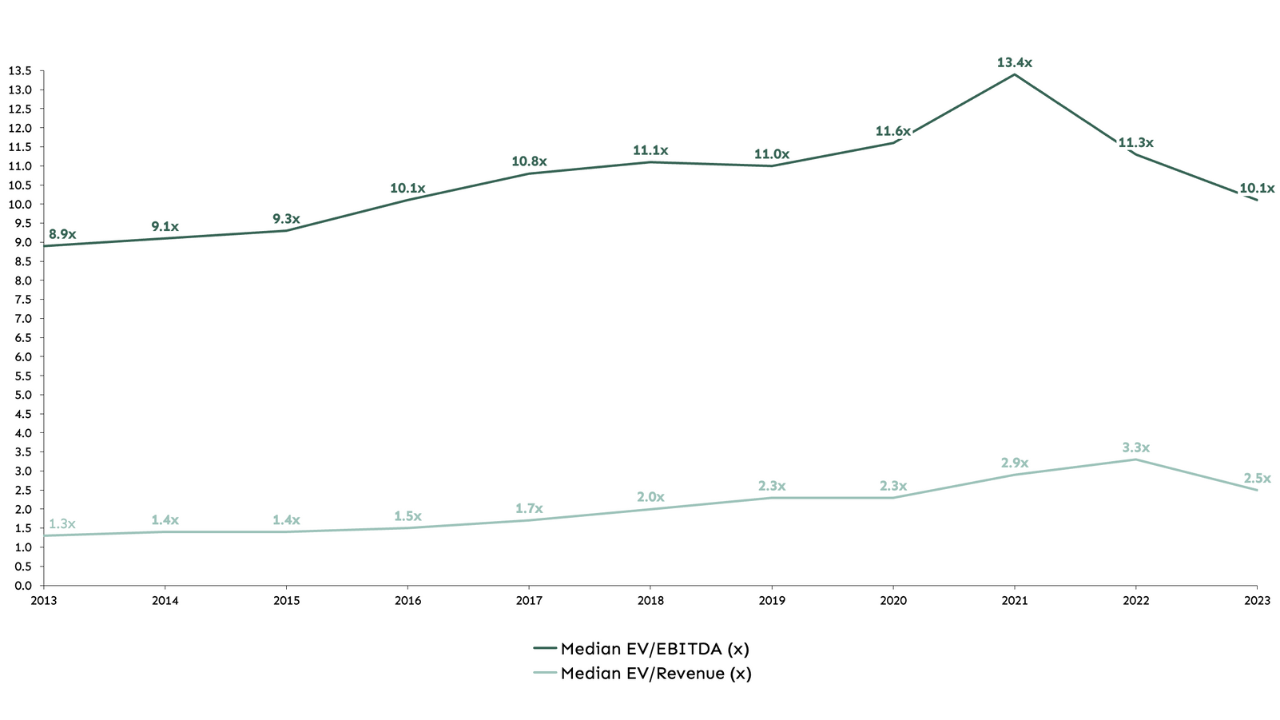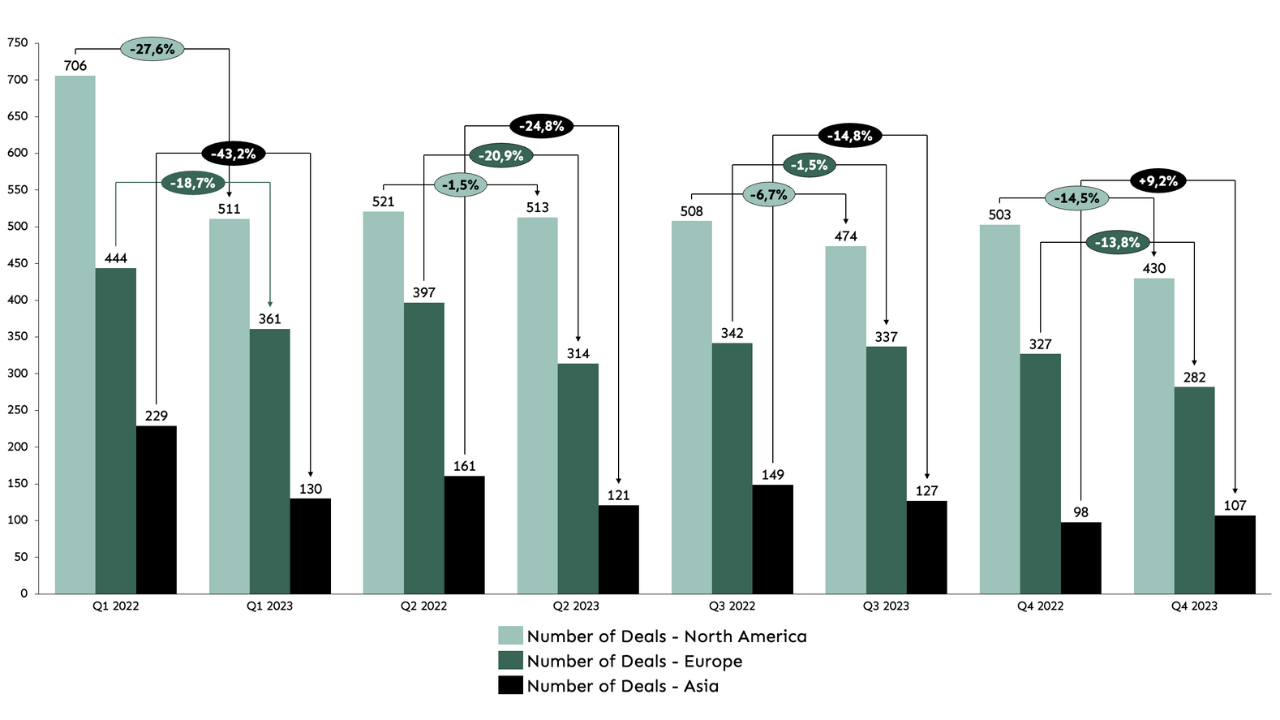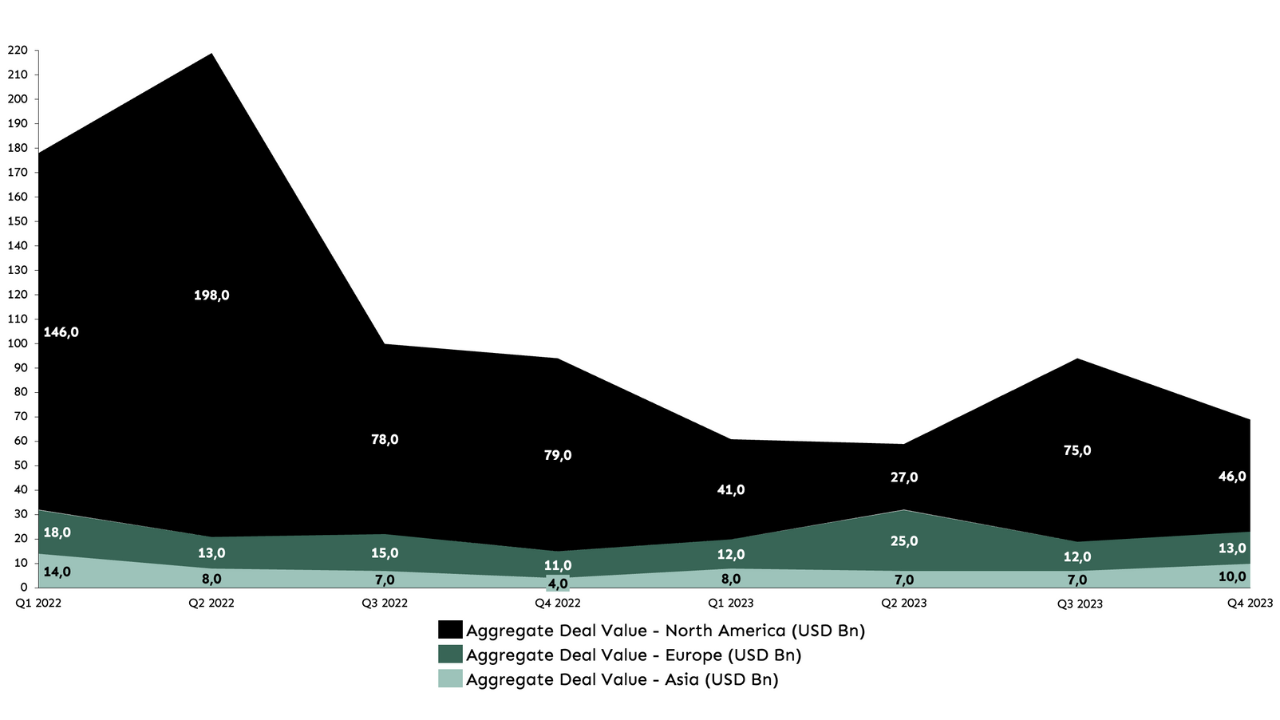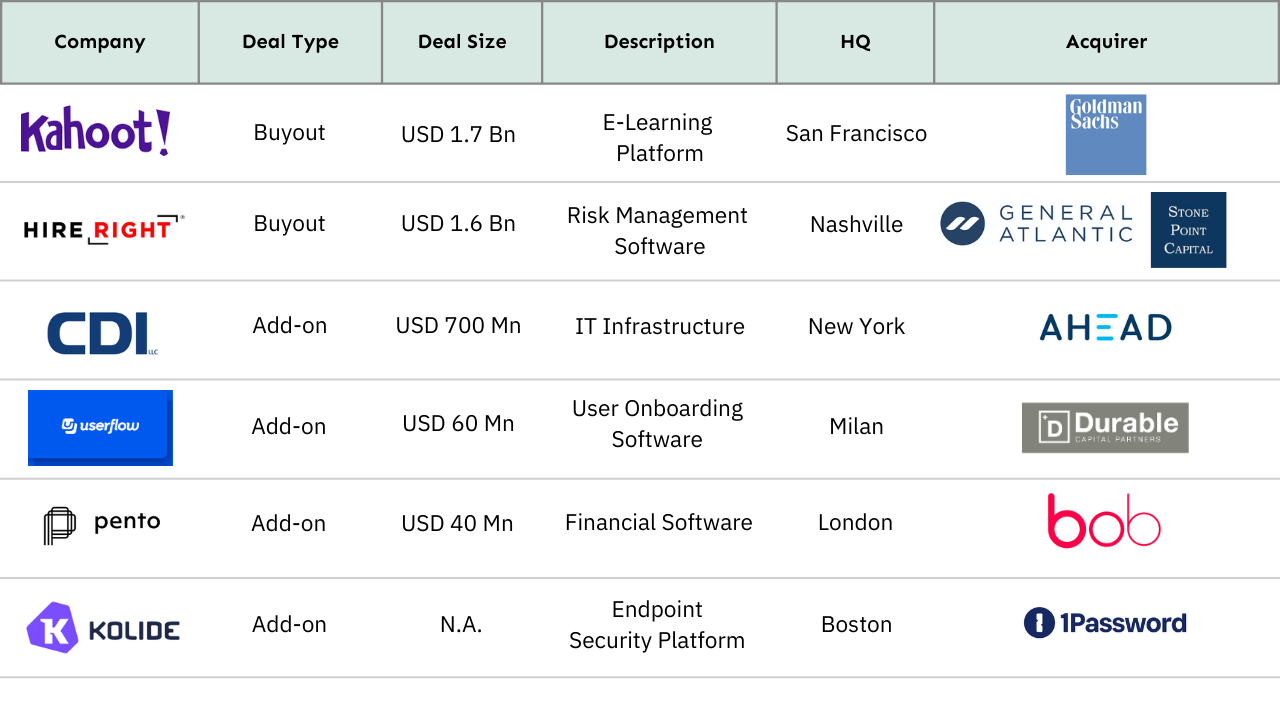Welcome to a brief recap of key deal metrics and highlights from 2023, along with insights into the trends shaping the tech M&A landscape in 2024. If you want to be the first one to receive these market and data updates, make sure to sign up for our Newsletter here.
Executive Summary:
- Geopolitical tensions, rising interest rates, and inflation are affecting M&A, as seen in declining tech sector multiples
- The Quarter-on-Quarter (QoQ) decrease in deal counts was consistent throughout 2022 and 2023 though notably, the largest differences occurred at the beginning of each year
- Aggregate deal value declined in late 2022 and early 2023, but rebounded later in 2023, suggesting a positive trend for tech M&A in 2024
- Lower inflation, expected interest rate cuts, and the recovery of stock markets have and are expected to result in the bounce-back of financial markets and therefore higher deal counts and multiples
- AI is dominant in Tech M&A, and expected to drive many transactions in 2024 due to high interest and consistent multiples. CEOs are planning substantial investments in AI, recognizing its significant impact on business operations
- With public listings quieting down, dealmakers are turning to M&A as an alternative exit strategy
- Amidst the M&A downturn, small to mid-sized deals performed better due to programmatic M&A. This trend is expected to continue and grow in 2024, especially in the small- to mid-cap sector
- The tech industry faced challenges in 2023, but industry players are showing optimism, predicting modest growth in 2024 and strong prospects for 2025.
- Venture-backed tech companies enhanced capital efficiency in 2023 due to a lack of follow-on financing, priming them for increased M&A activity.
Tech M&A Multiples Global

Source: Preqin March 2024
The global economy, and consequently the M&A landscape, is grappling with persistent core inflation, rising interest rates, and heightened geopolitical tensions unseen in the past two decades. These factors collectively hinder dealmaking: inflation curtails buying power, rising interest rates diminish the likelihood of borrowing money for deals, and increased geopolitical tensions risk countries and companies turning inward, away from cross-border deals.
This context explains the observed decline in EV/EBITDA and EV/Revenue multiples across all tech verticals. As central banks worldwide are anticipated to cut interest rates in 2024 (with the possibility of a new cycle of FED easing), and inflation subsides, geopolitical tensions continue to impact dealmaking negatively. Taking a closer look we are seeing optimism return to the market, as according to a recent S&P Global study, 48% of dealmakers anticipate multiples to increase, while 37% expect them to remain relatively stable.
Tech M&A Deal Count

Source: Preqin March 2024
When comparing QoQ data between 2022 and 2023, there is a consistent decrease in deal counts for every quarter except Q4, where Asia saw a 9.2% increase. A regional breakdown shows an average QoQ decrease of 12.4% in North America, 13.7% in Europe, and 18.4% in Asia. Notably, the largest differences between 2022 and 2023 were recorded at the beginning of the respective years, with the last two quarters showing a smaller difference. This jump in activity is another indicator for increasing optimism returning to the market.
Tech M&A Aggregate Deal Value

Source: Preqin March 2024
In 2023, the market has yet to reach the funding levels witnessed during the boom of 2021. The decline in tech stocks and a slowdown in the IPO market since the start of 2022 have dampened the industry’s momentum. Valuations established in 2021 did not maintain their strength in 2023, leading to many promising companies facing flat or down rounds. Startups tightened their budgets, and layoffs within the tech sector intensified throughout 2023. These combined factors have exerted downward pressure on valuations.
Tech M&A Outlook 2024
Improvement in financial markets
We already mentioned expected lower interest rates and inflation. In late Q4 of 2023, 80% of the stocks in the S&P 1500 moved above their 50-day moving average, a technical indicator of market breadth that is bullish for stocks. This implies a shift from selling to buying, and can be taken as an indication that the S&P 500 will do well over the next three, six and 12 months. In February, The S&P 500 gained 5.34%, bringing its year-to-date total return up to 7.11%, indicating a validation of this prediction, even though global stock indices have been dropping since record highs in February. But overall, the positive recovery from last year shows that stock markets no longer believe that inflation will play a debilitating challenge within the global economy.
Although credit markets have recovered, financing is more expensive than it has been for a decade, and the higher cost of capital will put downward pressure on valuations. This will require dealmakers to create more value to deliver the same returns as before. While the outlook is mostly positive (at least more positive than 2023), dealmakers still need to assess risk carefully and plan for different scenarios.
The improvements in financial markets are expected to result in higher deal counts (Morgan Stanley predicts a 50% increase) and higher multiples from strategic acquirers. We anticipate slight increases in valuations in 2024, with a significant rise in deal counts. Specific sectors, such as AI, are also expected to see profound valuation increases.
Navigating AI challenges and opportunities
When examining the Tech M&A deals last year and Year to Date (YTD), one vertical stands out as particularly dominant: Artificial Intelligence. Given the current trajectory of the tech sector, we anticipate AI to drive a significant number of transactions in 2024. With the ongoing surge of interest in AI, multiples have remained consistently high. According to the EY-Parthenon CEO outlook survey, all surveyed CEOs expressed plans for substantial investments in AI. However, they are cognizant that the precise direction of this technology’s evolution may not be as clear as it appears at present. Among the reasons are increasing regulation and compliance, alongside the substantial associated risks, such as their impact on the workforce, lack of transparency, and ethical dilemmas.
What can be said with certainty is that 2023 was the year when many CEOs recognized the significant impact AI will have on their business operations (over 60% of business owners believe that AI will increase productivity). Moreover, 2023 demonstrated to leaders worldwide what the near future of AI will look like. With awareness of the AI agenda widespread and its impact visible and tangible to all, an increase in investment in this sector can be anticipated.
M&A as an alternative for IPOs
As public listings quiet down, dealmakers are increasingly turning to M&A as an alternative exit strategy, selling to corporates or private equity buyout funds. Opinions on this trend vary: some anticipate a resurgence in IPO activity, due to expected cuts in interest rates, lower inflation and several listings in the pipeline, while others predict a continued low. However, if public listings continue to stay quiet, M&A could emerge as the primary method to monetize growth.
Increase in small-to mid-cap sector growth M&A
Despite the M&A downturn, small to mid-sized deals fared better amidst market turmoil than larger deals. This resilience stems from the rise of programmatic M&A, where companies pursue multiple smaller acquisitions annually for growth. Recent McKinsey research highlights that programmatic acquirers significantly outperformed peers relying solely on organic growth. Given its resilience to market conditions, the case for programmatic M&A is stronger than ever. We anticipate this trend to continue and grow further in 2024, particularly within the small- to mid-cap sector.
Optimistic forecasts for the tech sector
The tech industry has faced challenges since its peak in the early pandemic years, with global tech spending slightly weakening and rising layoffs in 2023. However, a Q4 2023 Deloitte survey of 122 tech executives showed optimism, with 55% rating the industry as “healthy” or “very healthy.” Analysts predict modest growth for tech in 2024 and stronger prospects for 2025, with global IT spending expected to grow by 5.7% to 8%. Driving this rebound will be double-digit growth in software and IT services spending, a more than 20% increase in public cloud spending, and growing demand for cybersecurity and AI investments. Economists project global AI-related investments to reach $200 billion by 2025, led by the US.
Increase in M&A due to lack of follow-on financing
In addition, venture-backed tech companies were compelled to enhance capital efficiency in 2023 due to a lack of follow-on financing. The improvements made in many cases have now positioned these companies for M&A activities. We anticipate a significant rise in capital-efficiency related M&A transactions involving former VC-backed companies that are not yet prepared for another fundraising round but are indeed ripe for acquisition by strategic players in the industry. For these strategic acquirers, such acquisitions remain an efficient means to expand both vertically and horizontally.
Notable Transactions

Did you know that we started publishing on Medium? Make sure to check it out here.
